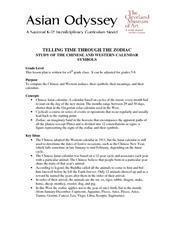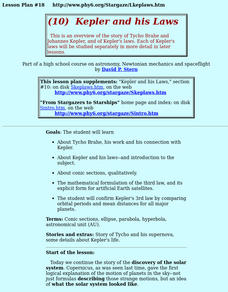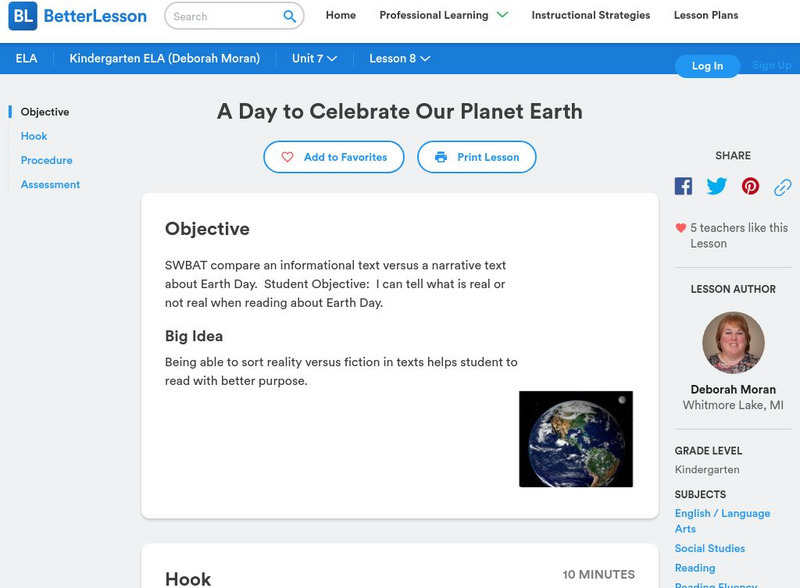Curated OER
Global Change — Change and Cycles Where Land, Air and Water Meet
Students participate in an experiment to define a parts-per-billion solution. In this ecology lesson, students select a second substance to create a parts-per-billion solution and observe and record their results. Students work in groups...
Curated OER
Aquatic Organisms
Students create a poster describing the five characteristics of a salt water organism compared to a fresh water organism.
Curated OER
Will It Rain Today or Tomorrow?
Pupils examine how to forecast weather. They examine the different types of weather and learn the correct vocabulary.
Curated OER
Telling Time Through the Zodiac
Learners compare the Chinese and Western zodiacs, their symbols, their meanings, and their calendars through a in-class discussion and a small group project. This instructional activity includes vocabulary and extensions.
Curated OER
Everybody Needs a Rock
Second graders examine science non-fiction books in the 500 section of the media center. They listen to Byrd Baylor's, Everybody Needs a Rock, and write a sentence that tells why everyone does need a rock. They illustrate the sentence.
Captain Planet Foundation
Worm Your Way Out of This
How can you provide healthy soil for your garden? Study worms, bacteria, and other microorganisms in a lesson about decomposition and organic compost. After discussing what you know about worms and watching a video, watch what worms do...
Curated OER
Sky Watching
Students explain how our knowledge of the sky has been enhanced by telescopes. They make their own night-sky observations, diagram and describe what they see, and examine pictures taken by telescopes.
Curated OER
Water Works Wonders
Students examine where water is found in the world, how we use it, and the various forms it takes. They observe the refraction of light through a prism, record the day and night sky over a week's time, and create a topographic model of...
Curated OER
The Mathematical Dynamics of Celestial Navigation and Astronavigation
Students explore the different methods used in celestial Navigation and astronavigation. In this math lesson, students construct a sextant and demonstrate how it works.
Curated OER
Geology
Students, in groups, observe the effect of water and ice on surface features of the land. They alsoexplore erosion and deposition.
Curated OER
Flying Through the Solar System
Learners create a model of the solar system out of candy. They write a book about their travels through the Solar System, beginning at age ten and reaching Pluto at age seventy.
Curated OER
A Relatively Far Out Idea: Estimating
Pupils investigate methods of estimating through cooperative group activities, hands-on activities, the use of tables and graphs and an interactive video.
Curated OER
Kepler And His Laws
Young scholars engage in an overview of the story of Tycho Brahe and Johannes Kepler, and of Kepler's laws. Each of Kepler's laws be studied separately in more detail in later lessons. They examine Kepler's 3rd law.
Curated OER
Sky Watching
Young scholars examine telescopes and understand how they have helped us better understand the sky. In this astronomy lesson students complete a worksheet and a lab activity.
Curated OER
Finding Jupiter's Moons
Learners explore Jupiter's Moons. They calculate and predict the location of Jupiter's 4 large moons. In addition, they draw Jupiter with its moons correctly shown for the time of the observation.
Curated OER
Is There Really Life on Mars?
High schoolers examine the work of scientists and determine how they test their theories.
Curated OER
A DISAPPEARING ACT Astronomy: Do Stars Always Shine?
Students observe why stars are not visible during the day with a classroom demonstration using an index card punched with holes.
Curated OER
Astronomical Scales
High schoolers describe the different units of measurement. In this space science lesson, students calculate astronomical distances using a scale. They explain the significance of using scientific notation in expressing very small...
Curated OER
Have and Have-Not
Students describe the differences of people living in developed and underdeveloped countries. They also identify how each type of country uses their resources. They develop an ecological footprint of the countries discussed.
Crayola
Crayola: Extraterrestrials Visit Earth (Lesson Plan)
Your students will love wrapping up a solar system unit with this activity! Children make their own "Travel brochure," about earth, trying to encourage extraterrestrials to visit, by comparing our planet to theirs. This lesson plan also...
Better Lesson
Better Lesson: A Day to Celebrate Our Planet Earth
Students will compare an informational text versus a narrative text about Earth Day. Included in this activity are videos and pictures of the activity in action, a printable Earth Day Venn Diagram, and a recycling activity.
PBS
Pbs News Hour Extra: Lesson Plan: Planets in Proportion
Students learn about the distance and relative size of the rest of the planets compared to the Earth and Sun. The lesson plan includes an assessment and extension activities.
























